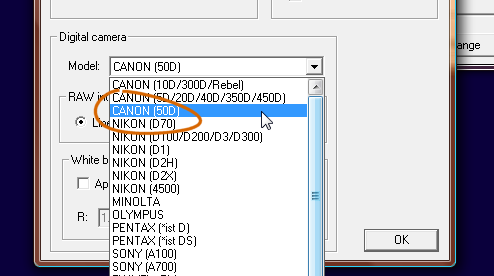
New features
of version 5.57
Version 5.57 - December 22, 2008
Support of Canon EOS5Dmk2 and Panasonic DMC-LX3.
Version 5.56 - November 21, 2008
Support of Canon EOS50D:

Improved LOADRAW (or LOADCFA) for a direct loading of DSLR RAW files from the command line (use CFA2RGB ou CFA conversion command from Digital Photo menu for convert toward colors).
Version 5.55 - May 18, 2008
Improved Lumenera camera acquistion (addition of 12-bits video).
Version 5.54 - May 10, 2008
Simple support of Lumenera Corporation B&W
series camera (tested on a SKYnyx-2-0M).
For take a snapshot or a sequence of snapshots, run the command Lumenera snapshot acquisition... from the Video menu:
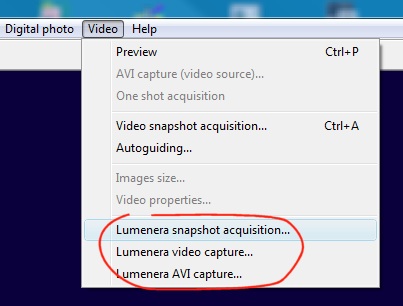
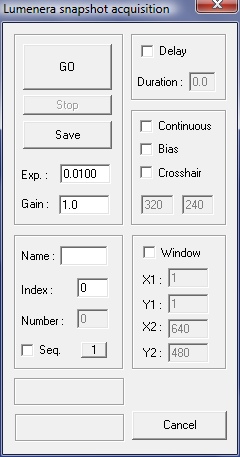
Note 1: the exposure time is given in seconds. Note 2: the gain is a value beetwen 1 and 16. Note 3: the snapshop Skynyx are 12 bits images.
For take a single shot from the console (ideal for long exposure), run the command:
LUCAM [EXPOSURE] [GAIN]
For examples:
>LUCAM 0.01 1
>LUCAM
2.7 5
The equivalence from the dialog box:
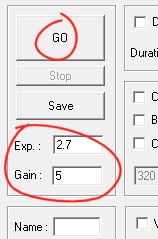
For take a sequence of images (here the sequence test1, test2, test3, test4, test5 stored in the working directory):
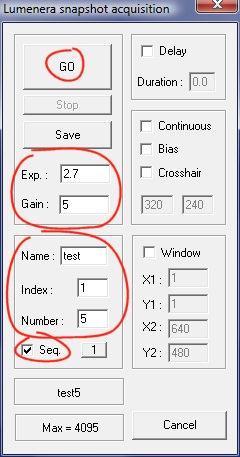
For capture on a portion of the image (crop):
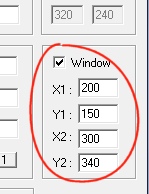
Here, the continuous acquisition mode (a oneshot "video" mode for long exposure, up to 100 msec):
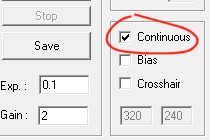
For a preview mode, run the command (the preview window appear at the upper left corner of the screen):
LUCAM_START
Note: you can take a snapshot during preview mode by using LUCAM command or the Lumenera snapshot aquisition dialog box.
For stop the preview mode:
LUCAM_STOP
For modify esposure time and gain during preview mode, run the command
LUCAM_SET [EXPOSURE] [GAIN]
For example:
>LUCAM_SET 1.5 4
An AVI file can be captured from the Lumenera source (8 bits data only, i.e. a standard AVI file). Use the command LUCAM_AVI:
LUCAM_AVI [AVI file] [EXPOSURE] [GAIN] [BINNING] [DURATION] [MODE]
The first parameter is the AVI file name (stored in the working directory, Iris add the extension .avi for you). The binning factor can be 1 or 2 (use binning=2 for very fast acquisition, up top 130 frames/sec). The parameter [duration] is the duration of the capture in seconds. If [mode] value is 0, a preview is also displayed. If [mode] value is 1, the video stream is captured without displaying it (the higher quality and frame rate mode). Example:
>LUCAM_AVI JUPITER 0.018 2 1 10 1
You can stop the capture by clicking the following buttom of the tool bar:
![]()
The equivalent dialog box interface is available from the command Lumenera AVI capture... (Video menu):
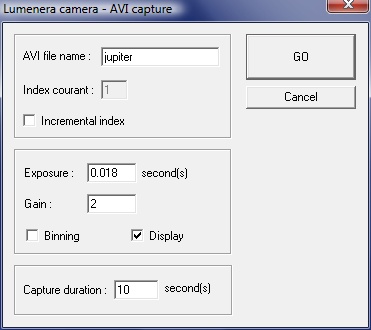
For convert the 8-bits AVI captured file to individual images, run the command AVI conversion... command ( File menu):
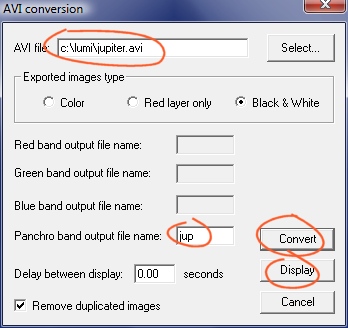
High rate acquisition with Lumenera camera. Click here for a demo.
For capture a fast sequence of 12 bits images (but with a limited exposure time duration) invoque the dialog box Lumenera video acquisition...
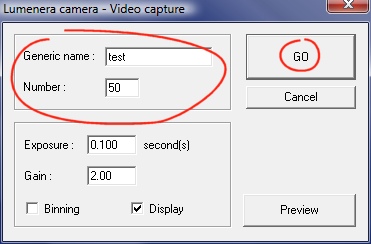
Here the sequence test1, test2, ..., test50 of individual images, corresponding to video frames, is saved into the hard disk. You can use also the equivalent command line LUCAM_VIDEO.
Version 5.53 - February 25, 2008
Version 5.53 now supports the 48-bit FITS
format (true color, 3 x 16 bits), as well for input and output. The
functionality available in the PIC format proprietary PIC are also now
available with the FITS. The PIC format retains some an advantage in terms of
disk loading and saving speed .
Astrometric calibrated FITS images are now compatible (partial) with WCS (World Coordinates System). WCS can map pixels in the image to right ascension and declination on the sky. In previous versions, only the fomat PIC had this property. For informations about WCS see http://fits.gsfc.nasa.gov/fits_wcs.html.
With Iris, the easiest way to achieve astrometric reduction is to call the dialog box Astrometry (map oriented) of Analysis menu. See for instance the documentation here:
- http://astrosurf.com/buil/iris/new550/new5502_us.htm
-
http://astrosurf.com/buil/iris/new552/new552_us.htm
You can also use the
powerful command SV1 for
process a large set of images pictures (see
http://astrosurf.com/buil/iris/new552/survey_us.pdf). The FITS
images generated
with Iris can be exported and used by many software. The example below show
the image of Messier 35 open cluster expoted in SAOImage
software after a gnomonic projection. The latter can display real-time coordinates of
the objects (with Iris you can use the command Compute command
of the context menu or the command line
REC2SKY).
|
|
|
The same Iris astrometric reduced
image (gnomonic projection) displayed into Iris (left) and into SAOImage
(right). The grid coordinates
were drawed by using the respective software. Images taken with a Canon 40D and a
85 mm focal length lens (expo. 3 x 30 s).
Teep: use the command INFO_ASTRO
for obtain informations about the actual astrometric reduction.
All sky mosaics under construction
in Iris, exported
toward the free software SAOImage. The image has a size of 10000 x 7500 pixels
and uses a Aitoff projection (WCS AIT projection). The FITS image is directly
recognized in SAOImage.
NEW COMMANDS
COASTROS [IMAGE1] [IMAGE2] [ADJUST MAGNITUDE (0 ou 1)]
COASTRO [IMAGE1] [IMAGE2] [ADJUST MAGNITUDE (0 ou 1)]
COASTROS2 [IN] [OUT] [ADJUST MAGNITUDE (0 ou 1)] [NUMBER]
Applied COASTROS command to a sequence of images.
COASTRO2 [IN] [OUT] [ADJUST MAGNITUDE (0 ou 1)] [NUMBER]
Applied COASTRO command to a sequence of images.
Here, typical applications...
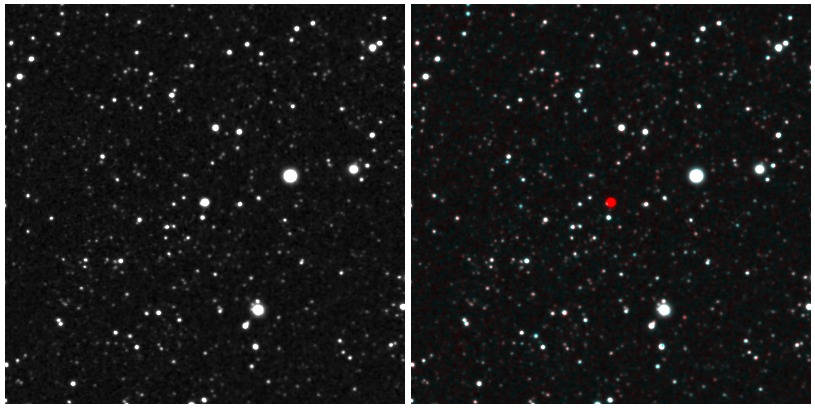
Left,
the field of variable star U Ori, the December 12, 2007, extracted from a wide-field
survey (Canon 40D + 85 mm f/1.2 @ f/2.0 - 90 sec.).
Right a synthetic "true"
colors image. The R channel is composed from the B&W image taken the
December 12, 2007. The G and B layer
are composed of an image (B&W) taken
the January 28, 2008 with the same instrument and geometricaly projected on
the same gnomonic reference.
The "color" of the variable (at the
center of the field !) traduct a magnitude variation between the two dates (the
colors are enhanced by using
the saturation tool of Visu menu). Many
variable stars (and nova, ...) can be find with this procedure...
|
|
|
|
|
|
For example, you can download compatibles
FITS images from the SkyView site
(http://skyview.gsfc.nasa.gov/cgi-bin/query.pl) . |